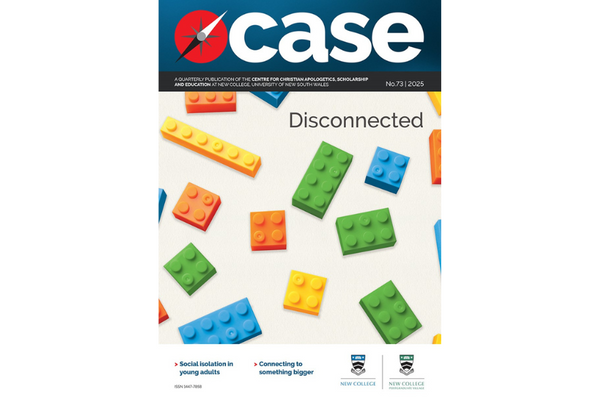Book Review: Life, the Universe and the Bible

Book Title: The Doubters Guide to the Bible
Author: John Dickson
Publishing Information: Zondervan, 2015, 224pp
The Doubter’s Guide to the Bible by John Dickson is a hard book to pigeonhole. The subtitle—Inside history’s bestseller for believers and skeptics—gives one reason for this. It’s not just written with believers in mind, nor is it written specifically for the non-believing skeptic. It’s written for… well … people. People who live in the same world that the Bible was written in and belong to the same history that the Bible belongs to. People whose stories are part of the broader story the Bible tells. People who constantly have to deal with conflicting information about all sorts of things—from whether eating salt is bad to whether the Bible is the answer to life the universe and everything, a conspiracy, or a collection of myths.
Dickson’s stated aim is to ‘give a sense of the whole biblical narrative and of the “theology” that emerges from it … to offer a snapshot of the worldview and lifestyle the Bible inspires’ (p11), and he achieves this admirably. The structure of the book parallels that of the Bible, with chapters on creation and the Fall, Abraham, Moses, Joshua, the Kingdom, Jesus’ birth and ministry, the work of the Church, and the new creation. Woven through these chapters are the threads of humanity’s social, spiritual and physical circumstances: our relationships with God, other people, and the physical world. We are shown the goodness of these in creation, how they are tainted by sin, ups and downs through the Old Testament, their reconciliation and redemption in Jesus, implications for Christian life and ethics, and the hope of their renewal in the new creation.
At its heart, then, The Doubter’s Guide is a book that tells the story of the Bible on its own terms. But it doesn’t stop there, and this is another reason the book is difficult to pigeonhole. It also shows how this story fits with ‘extra-biblical’ history, literature, archaeology and science. Dickson’s discussion of the creation story—a common stumbling block to taking the Bible seriously—is a case in point. He doesn’t flinch from acknowledging that Genesis can sound opposed to current science, and that Christians disagree on how to interpret it. In response he discusses the literary genre of the creation account, how symbolic readings go back to antiquity, and its relation to pagan creation accounts. While a small book can’t deal with these matters in depth, there is enough here to get an understanding of the main issues and see that there are reasonable answers to be found. For those who want more detail, further reading recommendations are provided.
Many other questions relevant to contemporary readers are dealt with along the way: judgement; God’s attitude to violence; various accusations of new atheists like Richard Dawkins; and whether it’s all just wishful thinking.
Trained as a historian, Dickson’s historical notes are especially helpful1: there are timelines scattered throughout plotting biblical history side by side with contemporaneous events; textual and archaeological evidence that confirms what the Bible says (or in some cases fails to confirm it); and suggested resources for finding out more. Dickson’s scholarly integrity is reassuring: evidential support is not overstated; limitations are noted; straw men are avoided.2 What we get, then, is a book that presents (in brief) the overall story of the Bible integrated with the story of us and our history and our world.
There are a couple of less than satisfying parts of the book. I found the explanation of the Christian’s relation to the Jewish Law confusing (though the discussion of the Law itself is excellent).3 Also, the discussion of the Christmas story in terms of hoping against hope, gives the impression of recommending irrational belief, which is out of kilter with the rest of the book’s emphasis on the reasonableness of the Bible’s claims. However, the final chapter, ‘How everything is good again: The re-creation story’ is a highlight. Popular quasi-Christian depictions of what lies beyond death have left many Christians as well as non-Christians with a distorted picture of the Bible’s account of heaven and the afterlife, and the implications for life now. This chapter is an excellent remedy.
I wish there were more books like this. So often Bible teaching and apologetics are seen as mutually exclusive activities: one done on the Bible’s terms, the other on the world’s terms. Similarly Christians and non- Christians are often seen as mutually exclusive audiences. The Doubter’s Guide defies these divisions, treating people as people, and good scholarship as good scholarship. It tells the story of the Bible and deals with questions as they arise, in the terms relevant for the question. It acknowledges that questions sometimes straddle different disciplines. It acknowledges that Christians as well as non-Christians can be doubters, and that both groups will have questions they need answered—not only for overcoming sceptical objections, but for resilient confidence in the Bible.
You cannot read this book and come away thinking that the Bible exists in some kind of religious bubble that floats free of the world we inhabit, or that it is a collection of ancient writings with no relevance to life today. Itself difficult to pigeonhole, this book also makes it difficult to pigeonhole the Bible.
Who should read it? People interested in life, the universe and everything. There’s a better answer than 42.
E N D N O T E S
1 Although this book is not primarily about historical evidence for the Bible—Dickson has done this elsewhere (e.g. The Christ Files, The Life of Jesus. See www.johndickson.org/books.html for details).
2 The discussion on the alleged lack of evidence for the exodus is an excellent example of this (pp70f).
3 He writes that the ‘light of the Old Testament Law is refracted through the prism of the Christ-event’ (p85). Admittedly, I haven’t read the book Dickson recommends for people who want to understand this relationship more fully—perhaps if I did so the meaning of this image would be clearer—but it would be good if it was clearer in the text, and I hope Dickson will revisit it if there is a second edition.
Leave a comment
Comments will be approved before showing up.



